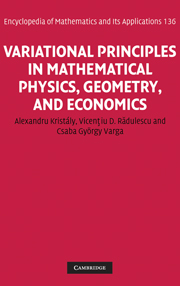 Variational Principles in Mathematical Physics, Geometry, and Economics
Variational Principles in Mathematical Physics, Geometry, and Economics Book contents
- Frontmatter
- Contents
- Foreword
- Preface
- Part I Variational principles in mathematical physics
- Part II Variational principles in geometry
- Part III Variational principles in economics
- 13 Mathematical preliminaries
- 14 Minimization of cost-functions on manifolds
- 15 Best approximation problems on manifolds
- 16 A variational approach to Nash equilibria
- 17 Problems to Part III
- Appendix A Elements of convex analysis
- Appendix B Function spaces
- Appendix C Category and genus
- Appendix D Clarke and Degiovanni gradients
- Appendix E Elements of set-valued analysis
- References
- Notation index
- Subject index
15 - Best approximation problems on manifolds
from Part III - Variational principles in economics
Published online by Cambridge University Press: 05 June 2013
- Frontmatter
- Contents
- Foreword
- Preface
- Part I Variational principles in mathematical physics
- Part II Variational principles in geometry
- Part III Variational principles in economics
- 13 Mathematical preliminaries
- 14 Minimization of cost-functions on manifolds
- 15 Best approximation problems on manifolds
- 16 A variational approach to Nash equilibria
- 17 Problems to Part III
- Appendix A Elements of convex analysis
- Appendix B Function spaces
- Appendix C Category and genus
- Appendix D Clarke and Degiovanni gradients
- Appendix E Elements of set-valued analysis
- References
- Notation index
- Subject index
Summary
If that enabled us to predict the succeeding situation with the same approximation, that is all we require, and we should say that the phenomenon had been predicted, that it is governed by the laws.
Henri Poincaré (1854–1912)Introduction
One of the most famous questions of functional and numerical analysis is the best approximation problem: find the nearest point (also called the projection) from a given point to a nonempty set, both situated in an ambient space endowed with a certain metric structure by means of which one can measure metric distances. In the classical theory of best approximations, the ambient space has a vector space structure, and the distance function is symmetric, which comes from a norm or, in particular from an inner product. However, nonsymmetry is abundant in important real life situations; indeed, it is enough to consider swimming (with/against a current) in a river, or walking (up/down) a mountain slope. These kinds of nonsymmetric phenomena lead us to spaces with no possible vector space structure, while the distance function is not necessarily symmetric; see also Chapter 14. Thus, the most appropriate framework is to consider not necessarily reversible Finsler manifolds. This nonlinear context throws completely new light upon the problem of best approximations where well-tried methods usually fail.
The purpose of this chapter is to initiate a systematic study of best approximation problems on Finsler manifolds by exploiting notions from Finsler geometry as geodesics, forward/backward geodesically completeness, flag curvature, fundamental inequality of Finsler geometry, and first variation of arc length.
- Type
- Chapter
- Information
- Variational Principles in Mathematical Physics, Geometry, and EconomicsQualitative Analysis of Nonlinear Equations and Unilateral Problems, pp. 289 - 303Publisher: Cambridge University PressPrint publication year: 2010
